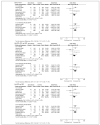NOD2/CARD15 gene polymorphisms and sarcoidosis susceptibility: review and meta-analysis
- PMID: 32476890
- PMCID: PMC7170086
- DOI: 10.36141/svdld.v35i2.6257
NOD2/CARD15 gene polymorphisms and sarcoidosis susceptibility: review and meta-analysis
Abstract
Background: The association between NOD2/CARD15 (nucleotide binding oligomerisation domain containing 2) gene polymorphisms and susceptibility to sarcoidosis have been extensively investigated in recent years. However, the results from previous studies remain controversial. To assess the association of NOD2/CARD15 polymorphisms and sarcoidosis susceptibility, we performed a meta-analysis. Methods: PubMed, Embase, CNKI and Wanfang databases were examined for all relevant studies up until 8th October 2016. In all, 968 cases and 1549 controls in eight case-control studies were included which mainly consisted of Caucasian participants. The relevant data were extracted and the odds ratio (OR) with 95% confidence intervals (95% CI) calculated to assess the strength of any associations. Statistical analyses were calculated using STATA12.0 software and Revman5.3 software. The associations between NOD2/CARD15 SNP rs2066844, rs2066845, rs2066847, rs1861759 polymorphisms and the risk of sarcoidosis were evaluated in allelic, dominant, recessive and additive models. Results: The pooled data showed that the NOD2/CARD15 rs2066845 polymorphism was associated with sarcoidosis susceptibility in allelic model (C vs. G, OR=1.86, 95% CI: 1.14-3.04, P=0.01), dominant model (GC + CC vs. GG, OR=1.84, 95% CI: 1.11-3.05, P=0.02) and additive model (GC vs. GG, OR=1.79, 95% CI: 1.08-2.97, P=0.02). However, the results suggested that the rs2066844, rs2066847 and rs1861759 polymorphisms might not be associated with a risk of sarcoidosis. Conclusions: This meta-analysis indicated that the 'C' allele of SNP rs2066845 may be a risk factor for sarcoidosis, especially in Caucasians, whilst rs2066844, rs2066847 and rs1861759 may not be associated with a risk of developing sarcoidosis. (Sarcoidosis Vasc Diffuse Lung Dis 2018; 35: 115-122).
Keywords: CARD15. genetic susceptibility; meta-analysis; polymorphism; sarcoidosis.
Copyright: © 2018.
Figures


Similar articles
-
NOD2 polymorphisms associated with cancer risk: a meta-analysis.PLoS One. 2014 Feb 20;9(2):e89340. doi: 10.1371/journal.pone.0089340. eCollection 2014. PLoS One. 2014. PMID: 24586700 Free PMC article.
-
Meta-analysis of NOD2/CARD15 polymorphisms with psoriasis and psoriatic arthritis.Rheumatol Int. 2012 Jul;32(7):1893-900. doi: 10.1007/s00296-011-1813-2. Epub 2011 Mar 30. Rheumatol Int. 2012. PMID: 21448648
-
CARD15/NOD2 polymorphisms are associated with severe pulmonary sarcoidosis.Eur Respir J. 2010 Feb;35(2):324-30. doi: 10.1183/09031936.00010209. Epub 2009 Aug 13. Eur Respir J. 2010. PMID: 19679608
-
The influence of single nucleotide polymorphisms of NOD2 or CD14 on the risk of Mycobacterium tuberculosis diseases: a systematic review.Syst Rev. 2021 Jun 9;10(1):174. doi: 10.1186/s13643-021-01729-y. Syst Rev. 2021. PMID: 34108050 Free PMC article.
-
Association between rs738409 polymorphism in patatin-like phospholipase domain-containing protein 3 (PNPLA3) gene and hepatocellular carcinoma susceptibility: Evidence from case-control studies.Gene. 2019 Feb 15;685:143-148. doi: 10.1016/j.gene.2018.11.012. Epub 2018 Nov 4. Gene. 2019. PMID: 30403964 Review.
Cited by
-
Inborn Errors in the LRR Domain of Nod2 and Their Potential Consequences on the Function of the Receptor.Cells. 2021 Aug 9;10(8):2031. doi: 10.3390/cells10082031. Cells. 2021. PMID: 34440800 Free PMC article. Review.
-
Clinical phenotype, NOD2 genotypes, and treatment observations in Yao syndrome: a retrospective case series.Front Immunol. 2024 Oct 4;15:1304792. doi: 10.3389/fimmu.2024.1304792. eCollection 2024. Front Immunol. 2024. PMID: 39430755 Free PMC article.
-
Inflammatory Bowel Disease: A Comprehensive Analysis of Molecular Bases, Predictive Biomarkers, Diagnostic Methods, and Therapeutic Options.Int J Mol Sci. 2024 Jun 27;25(13):7062. doi: 10.3390/ijms25137062. Int J Mol Sci. 2024. PMID: 39000169 Free PMC article. Review.
-
Exome Sequencing Reveals Genetic Variability and Identifies Chronic Prognostic Loci in Chinese Sarcoidosis Patients.Front Oncol. 2022 Jul 4;12:910227. doi: 10.3389/fonc.2022.910227. eCollection 2022. Front Oncol. 2022. PMID: 35860586 Free PMC article.
-
Models Contribution to the Understanding of Sarcoidosis Pathogenesis: "Are There Good Models of Sarcoidosis?".J Clin Med. 2020 Jul 31;9(8):2445. doi: 10.3390/jcm9082445. J Clin Med. 2020. PMID: 32751786 Free PMC article. Review.
References
-
- Statement on sarcoidosis. Joint Statement of the American Thoracic Society (ATS), the European Respiratory Society (ERS) and the World Association of Sarcoidosis and Other Granulomatous Disorders (WASOG) adopted by the ATS Board of Directors and by the ERS Executive Committee, February 1999. Am J Respir Crit Care Med. 1999;160:736–55. - PubMed
-
- Hugot JP, Chamaillard M, Zouali H, et al. Association of NOD2 leucine-rich repeat variants with susceptibility to Crohn’s disease. Nature. 2001;411:599–603. - PubMed
-
- Mann JK, Shen J, Park S. Enhancement of Muramyl Dipeptide-Dependent NOD2 activity by a self-derived peptide. J Cell Biochem. 2016;9999:1–12. - PubMed
-
- Schurmann M, Valentonyte R, Hampe J, et al. CARD15 gene mutations in sarcoidosis. Eur Respir J. 2003;22:748–54. - PubMed
-
- Moher D, Liberati A, Tetzlaff J, et al. Preferred reporting items for systematic reviews and meta-analyses: The PRISMA statement. Int J Surg. 2010;8:336–41. - PubMed
Publication types
LinkOut - more resources
Full Text Sources
Miscellaneous
